When making conversions between colour spaces, rendering intents are the different strategies that answer to the question "What how do we deal with the source colours that cannot be reproduced in the target colour space because it is smaller?"
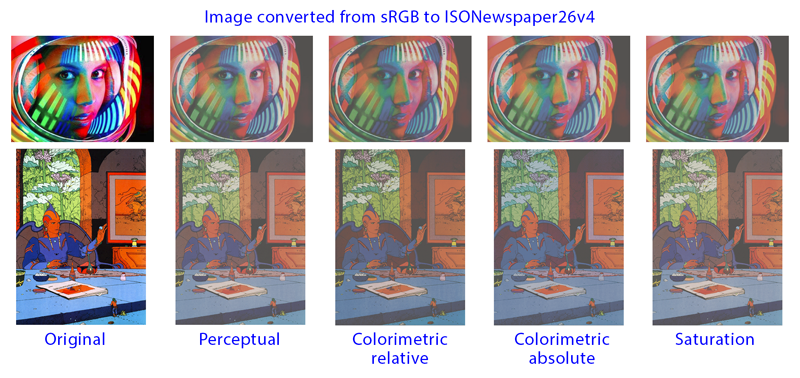
In the colour management approach adopted by the ICC and its colour profiles, there are four possible strategies that we describe below.
Warning: All four rendering intents presuppose that in most colour conversions some loss of hue will always occur.
Colorimetric (relative and absolute)
This rendering intent has two variants: Relative colorimetric and absolute colorimetric. Their difference lies in how the relationship between the white point (the lightest neutral colour, and consequently all other neutral hues) of the source and destination colour spaces are treated.
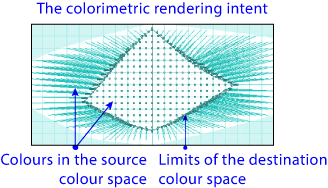
In both cases, colorimetric rendering intent is the strategy of passing the colours from the source space to the target space as they are. So, source colours that exist in the target space are not modified. But source colours that do not exist in the target space because the target is a smaller volume are reproduced with the closest hue that exists in that area: This means, for example, that if a bright vivid red hue from the source is outside the boundaries of the target space, it will be reproduced with the brightest possible red hue of the target space.
If source and target colour spaces are not very different in size, this is an good strategy because in a general sense the colour alterations won't be many. In fact, if the target colour space is larger (which is unusual), there will no alteration at all.
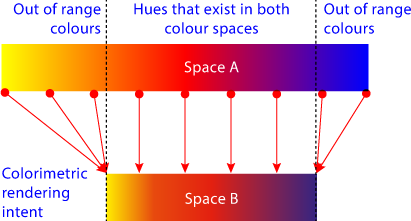
However, if there is a big difference in size, the outermost original colours (shadows, highlights and the most saturated ones) will be clipped and many colour differences will be flattened and disappear (as they will be converted to the same hue).
Colorimetric relative
In this rendering intent variant, the white point of the source space is translated to the target colour space. white point This is done because the human eye is particularly sensitive to the chromaticity of neutral tones and, if the lightest neutral tone is not adapted, the result will be perceived as having an obvious hue or dominant (too bluish or too yellowish, etc.). In other words: In relative rendering intent chromaticity, the source white is moved to the target white.
Together with the "perceptual" rendering intent, the "relative colorimetric" one is the most commonly used "default" rendering intent in colour profiles and both are the two most commonly used in graphic arts like printing and photography.
Colorimetric absolute
In this rendering intent, the adaptation of the source space to the target space is done without adapting the white point, which left as it is. This will often result in the destination having an obvious hue or dominance in its lighter areas (very bluish or very yellowish, etc.). In other words: In the colorimetric absolute rendering intent the source white point is not adapted to the destination's.
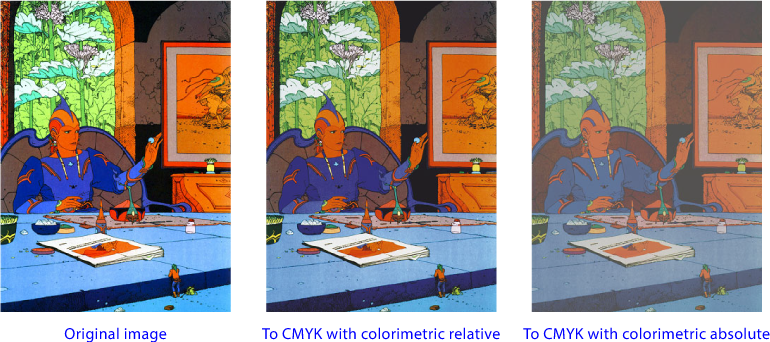
The reason why is that this rendering intent is used for colour proofing, which is the simulation on device A, with inks B and C, of how a job will look on device E, with inks D and paper F.
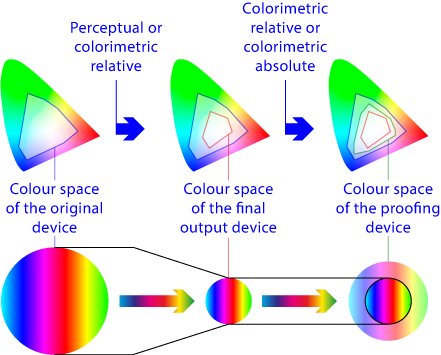
Warning: For the simulation (colour proof) to be carried out properly, the colour space describing the combination of A, B and C (the proofing device) must have a wider colour gamut than the colour space describing the combination of E, D and F. Otherwise, the proof will be wrong.
This rendering intent should be used only to make colour proofs.
Perceptual
This rendering intent assumes the strategy of moving the colours from the source space to the target space by changing them all, so as to maintain the overall colour feeling, that is: The relationship between the different colours that make up the image or element being converted. As with relative colorimetric, the white point of the source colour space is transferred to the destination's.
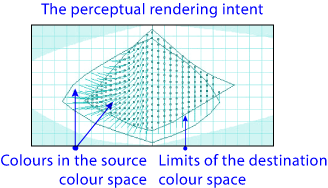
We could say the source colour space is treated like a foam rubber ball, which is squeezed into the destination. Thus, all hues are altered proportionally and unevenly (in some areas more tones will have to be compressed than in others).
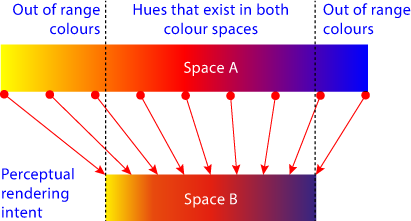
If the source and destination colour spaces have very different sizes, perceptual is a better strategy than relative colorimetric, as it tries to maintain the appearance of the relationship between colours.
As we said above, both "relative colourimetric" and "perceptual" are the most commonly chosen default rendering intents in colour profiles. In some applications perceptual is referred to as "photographic".
Warning: The ICC leaves the manufacturers and developers free to choose the procedures to compress or reshuffle of colours. Therefore, different profiling programs may give relatively different results.
The main difference between perceptual and colorimetric rendering intents

We must stress again that the choice between both rendering intents to make a conversion is mainly due to the difference in tonal range between the source and destination colour spaces, especially in the areas that interest us most in the images concerned.
Saturation
In this last rendering intent, the main aim is to use the maximum of the destination colour space. The relationship between tones is not relevant. It can be compared to a inflatable balloon (albeit it does not work miracles and does not restore the lost saturation of an image).

It is a endering intent for office software, not graphic arts (where it is no really used). If the destination space is smaller, it is similar to the perceptual purpose (see below).
In some programmes it is called "presentation" instead of saturation.
Conversions in the output colour profiles
Rendering intents are performed using the data included in the colour profiles, which are the tool for their application.
In matrix colour profiles, there is only one rendering intent (equivalent to relative colorimetric), in table profiles there can be up to six tables (divided into two sets) for the rendering intents. Each one of these tables describe the colour conversions made using one rendering intent.
One group of tables are the three conversions from the profiled device (usually a CMYK one) to the connection colour space (Profile Connection Space: PCS, currently CIELAB or CIE XYZ 1931). The other set of three describes the opposite direction, from the PCS to the device. The tables are called:
- From the device to the PCS::
AtoB0: Perceptual.AtoB1: Colorimetric.AtoB2: Saturation.
- From the PCS to the device:
BtoA0: Perceptual.BtoA1: Colorimetric.BtoA2: Saturation.
The reason why there is only one "colorimetric" table is that the colour values of the relative colorimetric intent are obtained applying the white point (which is a specific label inside the profile) to those data, while those of the absolute colorimetric intent are just the data values without applying the new white point. That is why only one "colorimetric" table is necessary.
Profiles have a default rendering intent. In theory it should be the one used if the user or software do not decide otherwise. Nowadays graphic arts programs such as Adobe Photoshop or InDesign allow us to override it.
Warning: Not all colour profiles really include all the tables that correspond to the four rendering intents. In the case of output profiles (which must include the six tables), it is not uncommon for one table to repeat the data of another. In fact, it is usual that the saturation rendering intent, repeats the data of the perceptual one. In such cases, obviously, applying both intents yields the same results.
DeviceLink profiles, which are encapsulated colour conversions, have only a single rendering intent, which is chosen at the time of profile creation and cannot be changed.
Warning: These are the four traditional rendering intents, but this does not mean that they are the only ones possible. In fact, some very specialised programmes use other extra ones, but this is very unusual.
[© Gustavo Sánchez Muñoz, 2025] Gustavo Sánchez Muñoz (also identified as Gusgsm) is the author of the content of this page. Its graphic and written content can be shared, copied and redistributed in whole or in part without the express permission of its author with the only condition that it cannot be used for directly commercial purposes (that is: It cannot be resold, but it can form part as reasonable quotations in commercial works) and the legal terms of any derivative works must be the same as those expressed in this statement. The citation of the source with reference to this site and its author is not mandatory, although it is always appreciated.